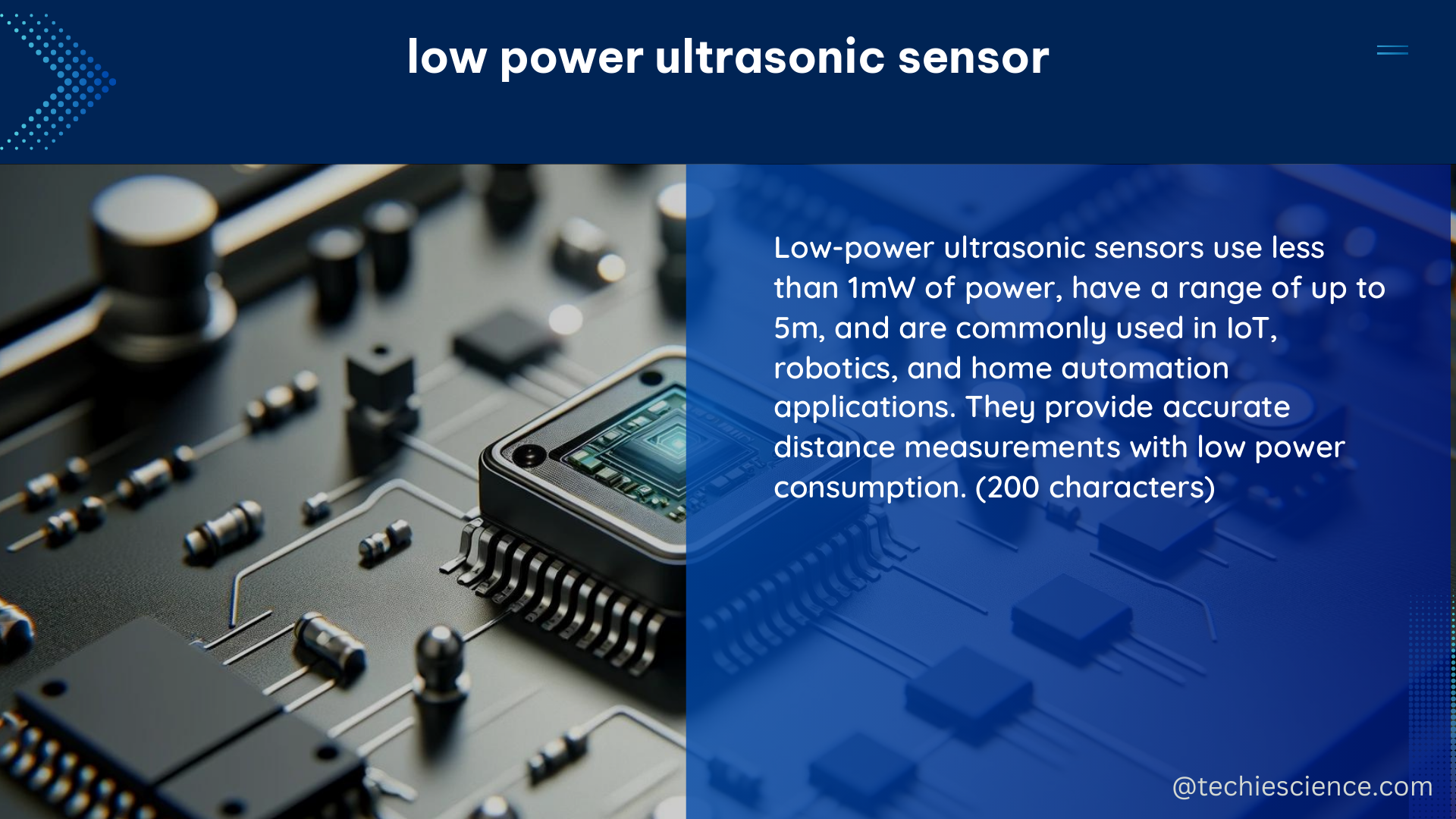Low power ultrasonic sensors are essential for a wide range of applications, including robotics, automation, and distance measurement. These sensors consume minimal power, making them ideal for battery-operated devices. One such low power ultrasonic sensor that has gained widespread popularity is the HC-SR04, which is commonly used with Arduino for distance measurement tasks.
Understanding the HC-SR04 Sensor
The HC-SR04 sensor is a compact and cost-effective ultrasonic sensor that operates at a frequency of 40KHz. It has an operating voltage of 5V DC and an operating current of just 15mA, making it a highly energy-efficient choice for your projects.
Sensor Specifications
| Specification | Value |
|---|---|
| Operating Voltage | 5V DC |
| Operating Current | 15mA |
| Operating Frequency | 40KHz |
| Minimum Range | 2cm / 1 inch |
| Maximum Range | 400cm / 13 feet |
| Accuracy | 3mm |
| Measuring Angle | < 15 degrees |
| Dimensions | 45 x 20 x 15mm |
The sensor consists of two ultrasonic transducers: one for transmitting ultrasonic sound pulses and the other for receiving the reflected waves. This design allows the HC-SR04 to accurately measure the distance to an object by calculating the time-of-flight (ToF) of the sound waves.
Interfacing the HC-SR04 with Arduino

Connecting the HC-SR04 sensor to an Arduino board is a straightforward process. The sensor requires four pins for communication: VCC, GND, Trig, and Echo.
- VCC: Connect this pin to the 5V pin on the Arduino board.
- GND: Connect this pin to the ground (GND) pin on the Arduino board.
- Trig: Connect this pin to any digital pin on the Arduino board. This pin is used to trigger the sensor and initiate the distance measurement.
- Echo: Connect this pin to another digital pin on the Arduino board. This pin will output a pulse width signal that corresponds to the time-of-flight of the ultrasonic waves.
To measure the distance using the HC-SR04 sensor, you can utilize the NewPing library, which is not included in the Arduino IDE by default. You’ll need to install it first by navigating to Sketch > Include Libraries > Manage Libraries and searching for “NewPing”.
Once the library is installed, you can use the provided functions to trigger the sensor and read the distance measurement. The NewPing.ping_cm() function, for example, will return the distance in centimeters, while the NewPing.ping_in() function will return the distance in inches.
Power Management Strategies
To further optimize the power consumption of the HC-SR04 sensor, you can implement a power management strategy using a MOSFET. By connecting the sensor’s power supply through a MOSFET, you can turn the sensor on and off as needed, reducing the overall power draw.
The MOSFET should have an extremely low on-resistance, typically around 0.05 ohms, to minimize the voltage drop and power loss. You can control the MOSFET using an Arduino digital pin, setting it to HIGH to turn the sensor on and LOW to turn it off.
This approach allows you to power down the HC-SR04 sensor between measurements, significantly reducing the overall power consumption and extending the battery life of your project.
Applications and Use Cases
The HC-SR04 low power ultrasonic sensor has a wide range of applications in various fields, including:
- Robotics: The sensor can be used for obstacle detection, navigation, and proximity sensing in autonomous robots and drones.
- Home Automation: The HC-SR04 can be integrated into smart home systems for applications such as automatic door opening, security monitoring, and water level detection.
- Industrial Automation: These sensors can be used for level monitoring, object detection, and distance measurement in industrial environments.
- IoT Devices: Low power ultrasonic sensors like the HC-SR04 are well-suited for battery-powered IoT devices, enabling them to operate for extended periods without the need for frequent battery replacements.
- DIY Projects: The HC-SR04 is a popular choice for hobbyists and makers working on various Arduino-based projects, such as distance-based games, proximity-triggered alarms, and more.
Conclusion
The HC-SR04 low power ultrasonic sensor is a versatile and energy-efficient solution for a wide range of applications. Its compact size, low power consumption, and ease of integration with Arduino make it a popular choice among makers, hobbyists, and professionals alike.
By understanding the sensor’s specifications, interfacing it with Arduino, and implementing power management strategies, you can unlock the full potential of the HC-SR04 and create innovative projects that push the boundaries of what’s possible with low power ultrasonic sensing technology.
References
- Turning Power On and Off to Ultrasonic Sensor HC-SR04
- How to Use the HC-SR04 Ultrasonic Sensor on Arduino
- Arduino and HC-SR04 Ultrasonic Sensor Tutorial
- Suggest an Ultrasonic Sensor

The lambdageeks.com Core SME Team is a group of experienced subject matter experts from diverse scientific and technical fields including Physics, Chemistry, Technology,Electronics & Electrical Engineering, Automotive, Mechanical Engineering. Our team collaborates to create high-quality, well-researched articles on a wide range of science and technology topics for the lambdageeks.com website.
All Our Senior SME are having more than 7 Years of experience in the respective fields . They are either Working Industry Professionals or assocaited With different Universities. Refer Our Authors Page to get to know About our Core SMEs.